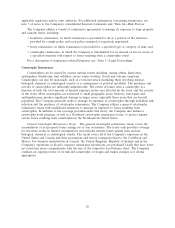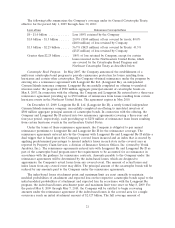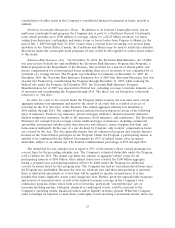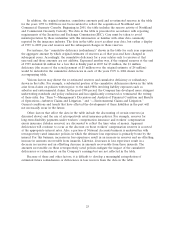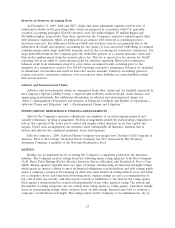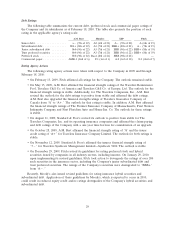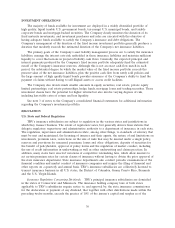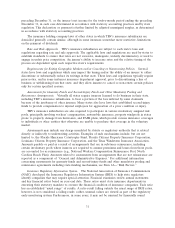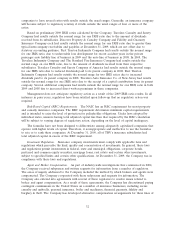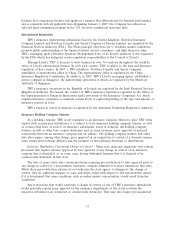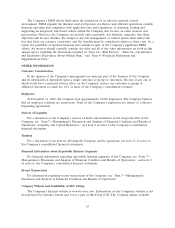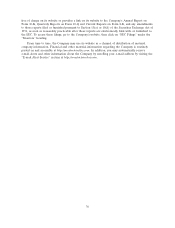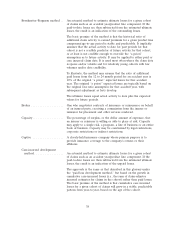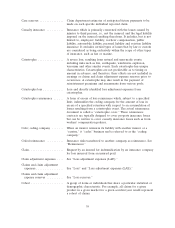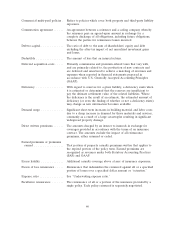Travelers 2009 Annual Report Download - page 42
Download and view the complete annual report
Please find page 42 of the 2009 Travelers annual report below. You can navigate through the pages in the report by either clicking on the pages listed below, or by using the keyword search tool below to find specific information within the annual report.INVESTMENT OPERATIONS
The majority of funds available for investment are deployed in a widely diversified portfolio of
high quality, liquid taxable U.S. government bonds, tax-exempt U.S. municipal bonds, and taxable
corporate bonds and mortgage-backed securities. The Company closely monitors the duration of its
fixed maturity investments, and investment purchases and sales are executed with the objective of
having adequate funds available to satisfy the Company’s insurance and debt obligations. The
Company’s management of the duration of the fixed income investment portfolio generally produces a
duration that modestly exceeds the estimated duration of the Company’s net insurance liabilities.
The primary goals of the Company’s asset liability management process are to satisfy the insurance
liabilities, manage the interest rate risk embedded in those insurance liabilities and maintain sufficient
liquidity to cover fluctuations in projected liability cash flows. Generally, the expected principal and
interest payments produced by the Company’s fixed income portfolio adequately fund the estimated
runoff of the Company’s insurance reserves. Although this is not an exact cash flow match in each
period, the substantial degree by which the market value of the fixed income portfolio exceeds the
present value of the net insurance liabilities, plus the positive cash flow from newly sold policies and
the large amount of high quality liquid bonds provides assurance of the Company’s ability to fund the
payment of claims without having to sell illiquid assets or access credit facilities.
The Company also invests much smaller amounts in equity securities, real estate, private equity
limited partnerships, real estate partnerships, hedge funds, mortgage loans and trading securities. These
investment classes have the potential for higher returns but also involve varying degrees of risk,
including less stable rates of return and less liquidity.
See note 3 of notes to the Company’s consolidated financial statements for additional information
regarding the Company’s investment portfolio.
REGULATION
U.S. State and Federal Regulation
TRV’s insurance subsidiaries are subject to regulation in the various states and jurisdictions in
which they transact business. The extent of regulation varies, but generally derives from statutes that
delegate regulatory, supervisory and administrative authority to a department of insurance in each state.
The regulation, supervision and administration relate, among other things, to standards of solvency that
must be met and maintained, the licensing of insurers and their agents, the nature of and limitations on
investments, premium rates, restrictions on the size of risks that may be insured under a single policy,
reserves and provisions for unearned premiums, losses and other obligations, deposits of securities for
the benefit of policyholders, approval of policy forms and the regulation of market conduct, including
the use of credit information in underwriting as well as other underwriting and claims practices. In
addition, many states have enacted variations of competitive ratemaking laws, which allow insurers to
set certain premium rates for certain classes of insurance without having to obtain the prior approval of
the state insurance department. State insurance departments also conduct periodic examinations of the
financial condition and market conduct of insurance companies and require the filing of financial and
other reports on a quarterly and annual basis. TRV’s insurance subsidiaries are collectively licensed to
transact insurance business in all U.S. states, the District of Columbia, Guam, Puerto Rico, Bermuda
and the U.S. Virgin Islands.
Insurance Regulation Concerning Dividends. TRV’s principal insurance subsidiaries are domiciled
in the states of Connecticut and Minnesota. The insurance holding company laws of both states
applicable to TRV’s subsidiaries require notice to, and approval by, the state insurance commissioner
for the declaration or payment of any dividend, that together with other distributions made within the
preceding twelve months, exceeds the greater of 10% of the insurer’s capital and surplus as of the
30


